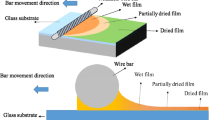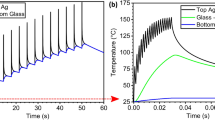Abstract
Advanced metal matrix composite (MMC) thin-film electrodes were fabricated utilizing single-wall carbon nanotubes (SWCNTs) as a reinforcement material. The MMCs were embedded with SWCNT thin films of 10, 20, and 50 nm thicknesses between thermally evaporated 1.5 µm Ag layers. A method has been developed to release the MMCs as free-standing films, and tensile testing was performed to evaluate the mechanical properties. The MMC containing a 20-nm SWCNT layer achieved a ~30 % increase in ultimate tensile strength, and a ~100 % increase in strain-to-failure, resulting in a ~150 % increase in toughness compared to Ag control samples. Scanning electron microscopy (SEM) analysis of the MMC microstructure revealed a decrease in Ag grain size with increased SWCNT loading, which correlated with the mechanical performance to identify the critical range of SWCNT layer thicknesses to achieve reinforcement. SEM also revealed SWCNTs protruding more than 1 μm from the fracture edges, indicating the potential of the MMCs to bridge micro-cracks in electrodes. The collective results show promise for SWCNT MMCs as an advanced electrode material capable of bridging micro-cracks in solar cells and flexible electronics.




Similar content being viewed by others
References
Tsai JTH, Hwang H-L (2009) Carbon nanotube reinforced conductors for flexible electronics. J Disp Technol 5(6):232–235
Kajari-Schröder S, Kunze I, Eitner U, Köntges M (2011) Spatial and orientational distribution of cracks in crystalline photovoltaic modules generated by mechanical load tests. Sol Energy Mater Sol Cells 95(11):3054–3059. doi:10.1016/j.solmat.2011.06.032
Köntges M, Kunze I, Kajari-Schröder S, Breitenmoser X, Bjørneklett B (2011) The risk of power loss in crystalline silicon based photovoltaic modules due to micro-cracks. Sol Energy Mater Sol Cells 95(4):1131–1137. doi:10.1016/j.solmat.2010.10.034
Chaturvedi P, Hoex B, Walsh TM (2013) Broken metal fingers in silicon wafer solar cells and PV modules. Sol Energy Mater Sol Cells 108:78–81. doi:10.1016/j.solmat.2012.09.013
Reijenga TH, Kaan HF (2016) PV in architecture. Handbook of photovoltaic science and engineering, 2nd edn. Rochester Institute of Technology, Rochester, pp 1043–1077
Phillips AB, Tompkins BL, Song Z, Khanal RR, Liyanage GK, Gapp ND, Wilt DM, Heben MJ (2015) Carbon nanotube reinforced cu metal matrix composites for current collection from space photovoltaics. In: 2015 IEEE 42nd Photovoltaic specialist conference (PVSC), 14–19 June 2015, pp 1–5. doi:10.1109/PVSC.2015.7355667
Feng Y, Yuan HL, Zhang M (2005) Fabrication and properties of silver-matrix composites reinforced by carbon nanotubes. Mater Charact 55(3):211–218. doi:10.1016/j.matchar.2005.05.003
Cha SI, Kim KT, Arshad SN, Mo CB, Hong SH (2005) Extraordinary strengthening effect of carbon nanotubes in metal-matrix nanocomposites processed by molecular-level mixing. Adv Mater 17(11):1377–1381. doi:10.1002/adma.200401933
Arnaud C, Lecouturier F, Mesguich D, Ferreira N, Chevallier G, Estournès C, Weibel A, Laurent C (2016) High strength–high conductivity double-walled carbon nanotube–copper composite wires. Carbon 96:212–215. doi:10.1016/j.carbon.2015.09.061
Bakshi SR, Singh V, Seal S, Agarwal A (2009) Aluminum composite reinforced with multiwalled carbon nanotubes from plasma spraying of spray dried powders. Surf Coat Technol 203(10–11):1544–1554. doi:10.1016/j.surfcoat.2008.12.004
Phuong DD, Van Trinh P, Van An N, Van Luan N, Minh PN, Khisamov RK, Nazarov KS, Zubairov LR, Mulyukov RR, Nazarov AA (2014) Effects of carbon nanotube content and annealing temperature on the hardness of CNT reinforced aluminum nanocomposites processed by the high pressure torsion technique. J Alloys Compd 613:68–73
Gill P, Munroe N (2012) Study of carbon nanotubes in Cu-Cr metal matrix composites. J Mater Eng Perform 21(11):2467–2471. doi:10.1007/s11665-012-0198-z
Shi L, Sun C, Gao P, Zhou F, Liu W (2006) Electrodeposition and characterization of Ni–Co–carbon nanotubes composite coatings. Surf Coat Technol 200(16):4870–4875
Espinosa H, Prorok B, Fischer M (2003) A methodology for determining mechanical properties of freestanding thin films and MEMS materials. J Mech Phys Sol 51(1):47–67
Chasiotis I, Bateson C, Timpano K, McCarty A, Barker N, Stanec J (2007) Strain rate effects on the mechanical behavior of nanocrystalline Au films. Thin Sol Film 515(6):3183–3189
Emery R, Povirk G (2003) Tensile behavior of free-standing gold films Part I. Coarse-grained films. Acta Mater 51(7):2067–2078
Haque M, Saif M (2004) Deformation mechanisms in free-standing nanoscale thin films: a quantitative in situ transmission electron microscope study. Proc Natl Acad Sci USA 101(17):6335–6340
Huang H, Spaepen F (2000) Tensile testing of free-standing Cu, Ag and Al thin films and Ag/Cu multilayers. Acta Mater 48(12):3261–3269
Wu Z, Chen Z, Du X, Logan JM, Sippel J, Nikolou M, Kamaras K, Reynolds JR, Tanner DB, Hebard AF, Rinzler AG (2004) Transparent, conductive carbon nanotube films. Science 305(5688):1273–1276. doi:10.1126/science.1101243
Landi BJ, Cress CD, Evans CM, Raffaelle RP (2005) Thermal oxidation profiling of single-walled carbon nanotubes. Chem Mater 17(26):6819–6834. doi:10.1021/Cm052002u
Landi BJ, Ruf HJ, Evans CM, Cress CD, Raffaelle RP (2005) Purity assessment of single-wall carbon nanotubes, using optical absorption spectroscopy. J Phys Chem B 109(20):9952–9965. doi:10.1021/Jp044990c
Rossi JE, Cress CD, Merrill A, Soule KJ, Cox ND, Landi BJ (2015) Intrinsic diameter dependent degradation of single-wall carbon nanotubes from ion irradiation. Carbon 81:488–496. doi:10.1016/j.carbon.2014.09.081
Li F, Cheng H, Bai S, Su G, Dresselhaus M (2000) Tensile strength of single-walled carbon nanotubes directly measured from their macroscopic ropes. Appl Phys Lett 77(20):3161–3163
Walters DA, Ericson LM (1999) Elastic strain of freely suspended single-wall carbon nanotube ropes. Appl Phys Lett 74(25):3803
Cox ND, Rossi JE, Landi BJ(2015) Carbon nanotube metal matrix composites for solar cell electrodes. In: 2015 IEEE 42nd photovoltaic specialist conference (PVSC), 14–19 June 2015, pp 1–4. doi:10.1109/PVSC.2015.7355867
Wilson K, Barrera EV, Bayazitoglu Y (2010) Processing of titanium single-walled carbon nanotube metal-matrix composites by the induction melting method. J Compos Mater 44(9):1037–1048. doi:10.1177/0021998310367263
Louchet F, Weiss J, Richeton T (2006) Hall-Petch law revisited in terms of collective dislocation dynamics. Phys Rev Lett 97(7):075504
Friedman LH, Chrzan D (1998) Scaling theory of the hall-petch relation for multilayers. Phys Rev Lett 81(13):2715
Acknowledgements
The authors gratefully acknowledge funding from the U.S. Government. This material is based on research sponsored by the Air Force Research Laboratory under Agreement Number FA9453-14-1-0232. The U.S. Government is authorized to reproduce and distribute reprints for Government purposes. The views and conclusions contained herein are those of the authors and should not be interpreted as necessarily representing the official policies or endorsements, either expressed or implied, of the Air Force Research Laboratory or the U.S. Government.
Author information
Authors and Affiliations
Corresponding author
Ethics declarations
Conflict of interest
The authors declare that they have no conflict of interest.
Rights and permissions
About this article
Cite this article
Cox, N.D., Rape, A., Pham, M. et al. Free-standing silver/carbon nanotube metal matrix composite thin films. J Mater Sci 51, 10935–10942 (2016). https://doi.org/10.1007/s10853-016-0305-x
Received:
Accepted:
Published:
Issue Date:
DOI: https://doi.org/10.1007/s10853-016-0305-x




